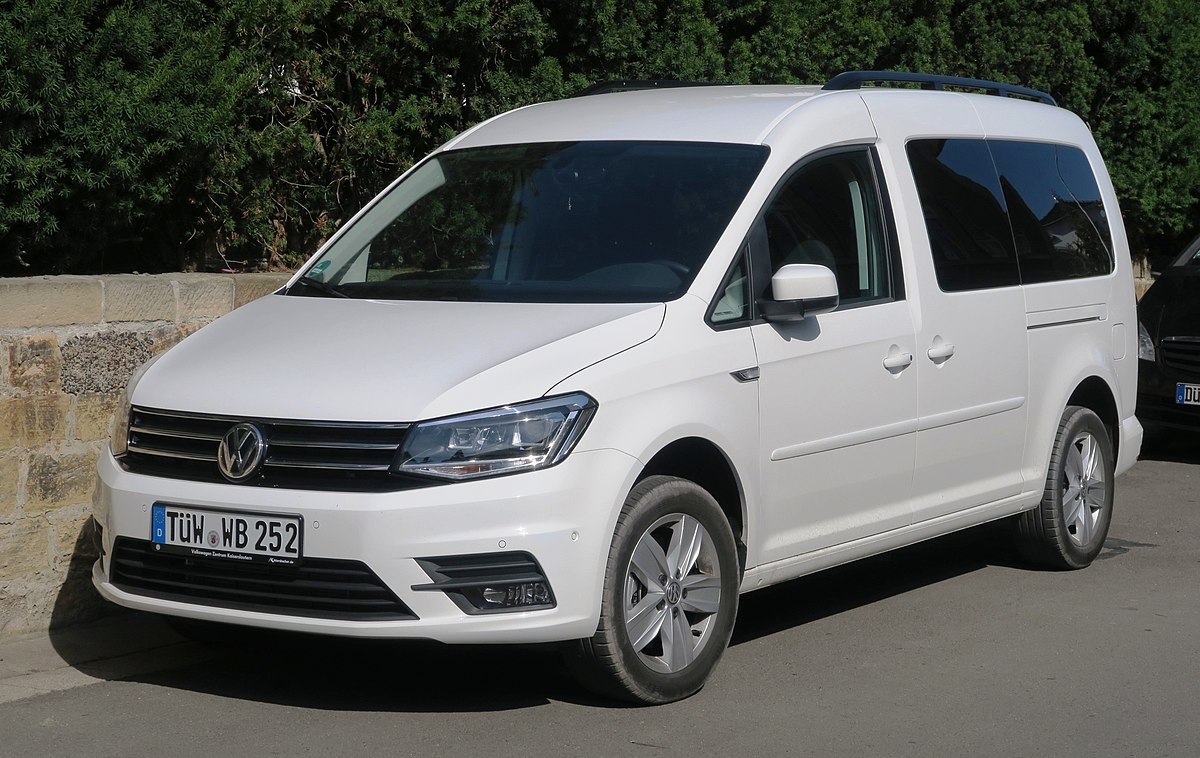
Volkswagen Caddy

| Volkswagen Caddy | |
|---|---|
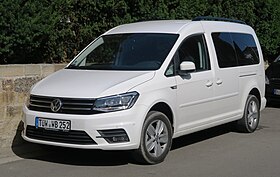
Caddy Typ 2K with 2015 facelift
|
|
| Overview | |
| Manufacturer | Volkswagen Group |
| Also called | Volkswagen Rabbit Pickup SEAT Inca Volkswagen Van |
| Production | 1980–present |
| Body and chassis | |
| Class | Leisure activity vehicle (M) |
| Body style | 3-/4-door van 3-door panel van 4-door MPV 2-door coupé utility |
| Layout | Front-engine, front-wheel-drive / four-wheel-drive (4motion) |
| Chronology | |
| Successor | Volkswagen Amarok (for pickup models) |
The Volkswagen Caddy is a leisure activity vehicle (M-segment) produced by the Volkswagen Group since 1980.
It is sold in Europe and in other markets around the world The Volkswagen Caddy was first introduced in North America in 1980 and in Europe in 1982 The first and second generations also had pick-up (coupe utility) variants
The following vehicles are related to the Volkswagen Caddy and are also manufactured by the Volkswagen Group.
- Typ 14 was derived from the Volkswagen Golf Mk1,
- Typ 9K was derived from the Volkswagen Polo Mk3 (Volkswagen Caddy) / SEAT Ibiza Mk2 (SEAT Inca) platform,
- Typ 9U was rebadged Škoda Felicia pickup,
- Typ 2K was derived from the Volkswagen Touran platform with Golf Mk5 front suspension.
First generation (Typ 14; 1979)
| First generation | |
|---|---|
 |
|
| Overview | |
| Also called | Volkswagen Rabbit Pickup |
| Production | 1979–1995 |
| Assembly |
|
| Body and chassis | |
| Related | Volkswagen Golf Mk1 |
| Powertrain | |
| Engine | 1.5 petrol 1.5 diesel (1980) 1.6 petrol 1.7 petrol 1.6 diesel w/turbo in Canada and abroad 1.8 petrol 1.6 petrol 63 kW 1.6 petrol 60 kW 1.6 diesel 44 kW 1.8 petrol 70 kW |
| Transmission | 4-speed manual |
| Dimensions | |
| Curb weight | 2,115–2,289 lb (959–1,038 kg) |

Released in 1979, the first Volkswagen Caddy, also known as Volkswagen Golf Mk1 Caddy is a coupe utility and van based on the Volkswagen Group A1 platform, shared with the small family car Volkswagen Golf Mk1.
Volkswagen Typ is:
- 147 = LHD (Left hand drive)
- 148 = RHD (Right hand drive)
Caddy debuts internationally as a Rabbit
The Caddy came to fruition when Volkswagen was experimenting with Golf derivatives, an estate and a pickup.
Volkswagen of America was interested in the pickup, and Volkswagen released the Volkswagen Rabbit Pickup in North America, produced at the Volkswagen Westmoreland Assembly Plant in Pennsylvania from 1978 to 1984. Trim levels such as LX and Sportruck were available.
In North America, the Caddy came with two engine choices. The 1.6L diesel and the 1.7L petrol. One unique feature of the diesel was that it came with a five-speed gearbox, with the fifth gear labeled as “E” or “Economy”. The Caddy actually was not called Caddy until 1982 when it was released in Europe.
The Volkswagen Rabbit Pickup competed with compact pickups, such as the Ford Courier, Datsun Truck, the Toyota Hilux and the Subaru BRAT.
The first cars under the name Rabbit Pickup were sold in the United States in 1979. Three years later, the model was introduced to Europe, where it was sold under the Caddy name.
Caddy debuts in Europe
The Caddy nameplate was never used in North America. Its first use was in Europe in 1982, when the Caddy came to Europe. European Caddys were built in Volkswagen's plant TAS in Sarajevo, Bosnia and Herzegovina, back then within SFR Yugoslavia, from 1982 till 1992.
The original Caddy was produced in South Africa until 2007, alongside the first generation Golf itself (which was sold until 2009). The stamping equipment was shipped from the closed plant in Westmoreland for both models.
Engine specs
The 1979–1984 Caddy pickup used the following engines:
- 1.5 petrol
- 1.5 diesel (1980): 35 kW (47 hp; 48 PS)
- 1.6 diesel
- 1.7 petrol
- 1.6 turbodiesel (not marketed in the United States)
- 1.8 petrol
However, during its long production in South Africa it has been available with the following engines:
- 1.6 petrol: 63 kW (84 hp; 86 PS)
- 1.6 petrol: 60 kW (80 hp; 82 PS)
- 1.6 diesel: 44 kW (59 hp; 60 PS)
- 1.8 petrol: 70 kW (94 hp; 95 PS)
Gallery
-

1981 Rabbit Diesel LX Pickup (US spec)
-

1981 Rabbit Diesel LX Pickup (US spec)
Second generation (Typ 9K/9U; 1996)
| Second generation | |
|---|---|
 |
|
| Overview | |
| Also called | SEAT Inca Volkswagen Van |
| Production | 1996–2004 |
| Assembly |
|
| Body and chassis | |
| Related | Volkswagen Polo Mk3 SEAT Ibiza 6K SEAT Inca Škoda Favorit Škoda Felicia |
| Powertrain | |
| Engine | 1.4L Petrol 44kW / 60hp 1.4L Petrol 16 valve 55kW / 75hp 1.6L Petrol 55kW / 75hp 1.7L Diesel SDI 42kW / 56hp 1.9L Diesel D 47kW / 64hp 1.9L Diesel SDI 47kW / 64hp 1.9L Diesel TDI 66kW / 90hp |
| Transmission | 5-speed manual |

Released in 1995, the Volkswagen Caddy Typ 9K, or Volkswagen Polo Caddy, was a light van, designed by Volkswagen's Spanish subsidiary SEAT, and derived from the SEAT Ibiza 6K, on the Volkswagen Group A03 platform.
It was built in Spain, at the Martorell factory of SEAT, from 1996 to 2004. Its twin, the SEAT Inca, was quickly phased out when the SEAT marque was re aligned as the "sporty" branch of the Volkswagen Group.
It was in production in Argentina until 2008 for the Latin American market. It received a cosmetic facelift in 2005, similar to the post 1999 Volkswagen Polo Mk3.
- Features
- length: 4.2 m (14 ft)
- loading area: 2.6 m2
- loading volume: 2.9 m3
- payload: 550 kg (1,210 lb)
- two rear wing doors – standard
- partition separating loading from driving space
- instruments with adjustable lighting
- power steering
- rear window heater
- rear windshield wiper
- dust and pollen filter
- side impact protection
- safety steering column with collapsible steering wheel
- two head restraints
- three point seatbelts
- drivers airbag; passenger airbag – optional
- ABS with Electronic Differential Lock (EDL)
- air conditioner
Note: The electronic differential lock (EDL) employed by Volkswagen is not — as the name suggests — a differential lock at all. Sensors monitor wheel speeds, and if one is rotating substantially faster than the other (i.e., slipping), the EDL system momentarily brakes it. This effectively transfers all the power to the other wheel.
| Model designation |
Engine code | Displacement | engine configuration |
Max. power at rpm (Directive 80/1269/EEC) |
Max. torque at rpm | 0–100 km/h (62 mph) | Top speed | Years |
|---|---|---|---|---|---|---|---|---|
| Petrol engines | ||||||||
| 1.4 MPI | AEX, APQ | 1,390 cc (85 cu in) | I4 SOHC 8v | 44 kW (60 PS; 59 hp) @ 4,700 | 116 N⋅m (86 lb⋅ft) @ 2,800–3,200 | 18.8 sec | 142 km/h (88 mph) | 1995–2003 |
| 1.4 MPI | AUA | 1,390 cc (85 cu in) | I4 DOHC 16v | 55 kW (75 PS; 74 hp) @ 5,000 | 126 N⋅m (93 lb⋅ft) @ 3,800 | 14.9 sec | 152 km/h (94 mph) | 2000–2003 |
| 1.6 SPI | 1F | 1,595 cc (97 cu in) | I4 SOHC 8v | 55 kW (75 PS; 74 hp) @ 5,500 | 125 N⋅m (92 lb⋅ft) @ 2,600 | 17.5 sec | 153 km/h (95 mph) | 1995–1997 |
| 1.6 MPI | AEE | 1,598 cc (98 cu in) | I4 SOHC 8v | 55 kW (75 PS; 74 hp) @ 4,800 | 135 N⋅m (100 lb⋅ft) @ 2,800–3,600 | 16.6 sec | 153 km/h (95 mph) | 1997–2000 |
| Diesel engines | ||||||||
| 1.7 SDI | AHB | 1,716 cc (105 cu in) | I4 SOHC 8v | 42 kW (57 PS; 56 hp) @ 4,200 | 112 N⋅m (83 lb⋅ft) @ 2,200–2,600 | 1996–2000 | ||
| 1.9 D | 1Y | 1,896 cc (116 cu in) | I4 SOHC 8v | 47 kW (64 PS; 63 hp) @ 4,400 | 124 N⋅m (91 lb⋅ft) @ 2,000–3,000 | 20.6 sec | 144 km/h (89 mph) | 1995–2003 |
| 1.9 SDI | AEY, AYQ | 1,896 cc (116 cu in) | I4 SOHC 8v | 47 kW (64 PS; 63 hp) @ 4,200 | 125 N⋅m (92 lb⋅ft) @ 2,200–2,800 | 20.1 sec | 144 km/h (89 mph) | 1995–2003 |
| 1.9 TDI | 1Z, AHU | 1,896 cc (116 cu in) | I4 SOHC 8v | 66 kW (90 PS; 89 hp) @ 4,000 | 202 N⋅m (149 lb⋅ft) @ 1,900 | 14.4 sec | 162 km/h (101 mph) | 1996–2000 |
| 1.9 TDI | ALE, ALH | 1,896 cc (116 cu in) | I4 SOHC 8v | 66 kW (90 PS; 89 hp) @ 3,750 | 210 N⋅m (155 lb⋅ft) @ 1,900 | 14.4 sec | 162 km/h (101 mph) | 1997–2003 |
Caddy Typ 9U


Released in 1996 to complement the Typ 9K Caddy range, the rebadged Škoda Felicia Utility was the entry level light commercial vehicle for the VWCV range.
The Typ 9U Caddy was built in Škoda Auto's Kvasiny, Czech Republic plant.
| Model designation |
Engine code | Displacement | engine configuration |
Max. power at rpm (Directive 80/1269/EEC) |
Max. torque at rpm | 0–100 km/h (62 mph) | Top speed | Years |
|---|---|---|---|---|---|---|---|---|
| Petrol engines | ||||||||
| 1.6 MPI | AEE | 1,598 cc (98 cu in) | I4 SOHC 8v | 55 kW (75 PS; 74 hp) @ 4,500 | 135 N⋅m (100 lb⋅ft) @ 3,500 | 12.5 sec | 161 km/h (100 mph) | 1996–2000 |
| Diesel engines | ||||||||
| 1.9 D | AEF | 1,896 cc (116 cu in) | I4 SOHC 8v | 47 kW (64 PS; 63 hp) @ 4,300 | 124 N⋅m (91 lb⋅ft) @ 3,000 | 16.5 s | 150 km/h (93 mph) | 1996–2000 |
- Features of Typ 9U Caddy
- 530 kg (1,170 lb) payload rating
- 2.0 m2 loading area
- twin airbags
- length: 4.12 m (13.5 ft)
- width: 1.64 m (5.4 ft)
- turning circle: 11.2 m (37 ft)
- 3 point seatbelts
- option of twin airbags
- option of ABS brakes
- option of air conditioning standard in Petrol model.
Third generation (Typ 2K; 2003)
| Third generation | |
|---|---|
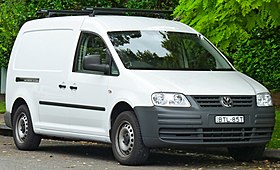 |
|
| Overview | |
| Production | 2003–2020 |
| Assembly |
|
| Body and chassis | |
| Related | Volkswagen Touran Mk1 |
| Powertrain | |
| Engine | 1.4 16V – 75 PS (55 kW; 74 hp) – 126 N⋅m (93 lb⋅ft) (petrol) (discontinued) 1.4 16V – 80 PS (59 kW; 79 hp) – 132 N⋅m (97 lb⋅ft) (petrol) 1.6 8V – 102 PS (75 kW; 101 hp) – 148 N⋅m (109 lb⋅ft) (petrol) 1.6 TDI – 75 PS (55 kW; 74 hp) – 225 N⋅m (166 lb⋅ft) (diesel) 1.6 TDI – 102 PS (75 kW; 101 hp) – 250 N⋅m (180 lb⋅ft) (diesel) 2.0 EcoFuel – 109 PS (80 kW; 108 hp) – 160 N⋅m (120 lb⋅ft) (CNG) 1.9 TDI – 75 PS (55 kW; 74 hp) – 210 N⋅m (150 lb⋅ft) (diesel) (discontinued) 1.9 TDI – 105 PS (77 kW; 104 hp) – 250 N⋅m (180 lb⋅ft) (diesel) (discontinued) 2.0 SDI – 69 PS (51 kW; 68 hp) – 140 N⋅m (100 lb⋅ft) (diesel) (only for panel van and panel window van) 2.0 TDI – 110 PS (81 kW; 110 hp) – 290 N⋅m (210 lb⋅ft) (diesel) 2.0 TDI – 140 PS (100 kW; 140 hp) – 320 N⋅m (240 lb⋅ft) (diesel) |
| Transmission | 5-speed manual 6-speed manual 6-speed dual-clutch 7-speed dual-clutch |
The third generation of Volkswagen Caddy debuted at the end of 2003, at the RAI Commercial Vehicle Show in Amsterdam, Volkswagen Commercial Vehicles debuted the Typ 2K Caddy panel van.
The Typ 2K shares 50% of its modules with the Volkswagen Golf Mk5 and Volkswagen Touran. The new model Caddy has a more aerodynamic design, the angle of the windscreen and A pillar is more horizontal, making the dashboard bigger and the bonnet (hood) smaller.
There are two body sizes: "normal" and Maxi. These can both be configured as a Panel Van, a Window Panel Van, Kombi (spartan passenger version), Caddy Life (family version), and a Camping version called the Caddy Tramper or Caddy Life Camper.
A Caddy Life or Kombi seats up to five in two rows while a Caddy Life Maxi or Kombi Maxi seats up to seven in three rows. The Life version has interior trimmings like that of a conventional five seater wagon while the Kombi is a naked panel van with windows and seats. The difference in road noise between the two is described by some as substantial.
Caddy Panel (2010–present)
The Caddy Panel grew in size over the Caddy Typ 9K, it measures in length 4,405 mm (173.4 in), width 1,802 mm (70.9 in), height 1,833 mm (72.2 in), wheelbase 2,682 mm (105.6 in), has a 750 kg (1,653 lb) payload, and a loading volume of 3.2 m3. The current shape Typ 2K Caddy, on sale in Europe since 2003, is a leisure activity vehicle with Volkswagen Golf Mk5 front suspension.
It resembles the compact MPV Touran, and is assembled at the Poznań factory in Poland. In May 2007, British Gas signed a landmark deal which saw 1,000 vans being supplied to the firm, which were fitted with a bespoke racking system and a speed limiter, designed by Siemens. The deal was renewed in September 2015.
Caddy Life

The Caddy Life, a seven-seat passenger oriented People Mover, debuted at the 2004 Geneva Motor Show. It comes with twin sliding doors and a 608 kg (1,340 lb) payload.
Caddy Life has a flexible seating system. The two rear bench seat rows can be taken out of the vehicle altogether to give the vehicle 2850 litres of cargo room; in addition, the Caddy Life has a 1,500 kg (3,307 lb) towing capacity.
In 2005, a Special Edition Caddy Life Colour Concept with two distinctive colours, Red Spice and Ravenna Blue, was released with upholstery fabrics, floor mats and a variety of other elements on the dash panel in the same colour as the exterior body, and a leather trimmed steering wheel, gear and handbrake lever.
Caddy Maxi and Caddy Maxi Life

Debuting at the 2007 Frankfurt Motor Show, Volkswagen Commercial Vehicles presented the Caddy Maxi Life the people mover version of the Maxi range. The Caddy Maxi range carried over all of the Caddy engine and debuted the 2.0L TDI engine producing 103 kW (138 hp; 140 PS).
The Caddy Maxi family is 470 mm (19 in) longer version of the Caddy with 4.2 m3 loading space, this is due to extensions of the wheelbase which measures 3,002 mm (118.2 in) an extended, rear overhang now 151 mm (5.9 in), plus the growth between the sliding doors and the rear axle now at 319 mm (12.6 in) and payload is up to 800 kg (1,764 lb) to 810 kg (1,786 lb) on commercial versions.
The Caddy Maxi Tramper, the camping version of the Caddy Maxi, debuted at the 2008 AMI Leipzig Motor Show along with the Caddy Maxi EcoFuel Study.
Caddy Life Tramper (Camper)
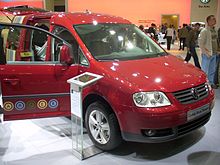
Based on the Caddy Life the Tramper or Camper (Australia) package comes with two seats and a table, a fold out awning that is packaged within the rear tailgate, a bed that is made by folding down the seats measures 1.10 m x 2.0 m, also curtains are standard for privacy, options include a seven-litre cool box.
Carrera Cup Edition
The Caddy Carrera Cup Edition is a limited (250 units) version for the Swedish market. It is based on the 2.0L TDi model with black 17 inch wheels with 225/45R17 tires, a new body kit, white body with red trim, black and red leather sport seats, a fire extinguisher under the passenger's seat, a sport leather steering wheel and gear knob.
The vehicle has MSRP of 250,000 Swedish krona (US$34,200 or €22,000).
Caddy 4Motion
At the 2008 IAA (Hannover Motor Show), Volkswagen Commercial Vehicles revealed the all wheel drive Caddy 4Motion range teamed with the 1.9 TDI engine and manual transmission.
Early in 2010, the Caddy Maxi range will receive the 4Motion drivetrain.
Caddy in Australia
Since its introduction in the Australian market in 2003, the Caddy range has taken the market lead for small vans, with a 42% share in 2007. Even with the more premium pricing over its competition, buyers are still willing to pay more for the TDI and DSG transmission options.
Awards
- Professional Van and Light Truck Magazine Small Van of the Year 2007 (United Kingdom)
- Van Fleet World Best Small Van 2007 (United Kingdom)
- Fleet News – 2008 Best Small Van Award
- Professional Van and Light Truck Magazine Small Van of the Year 2008 (United Kingdom) – Caddy Maxi
- Delivery Magazine Award – 2008 Best Small Van Caddy Maxi
- What Van? (United Kingdom) – Editor's Choice 2008 Caddy Maxi
Engines
- 1.2 – 86 PS (63 kW; 85 hp) – 160 N⋅m (118 lb⋅ft) (petrol)
- 1.2 TSI – 105 PS (77 kW; 104 hp) – 175 N⋅m (129 lb⋅ft) (petrol)
- 1.4 16V – 75 PS (55 kW; 74 hp) – 126 N⋅m (93 lb⋅ft) (petrol) (discontinued)
- 1.4 16V – 80 PS (59 kW; 79 hp) – 132 N⋅m (97 lb⋅ft) (petrol) (discontinued)
- 1.6 8V – 102 PS (75 kW; 101 hp) – 148 N⋅m (109 lb⋅ft) (petrol) (discontinued)
- 1.6 TDI – 75 PS (55 kW; 74 hp) – 225 N⋅m (166 lb⋅ft) (diesel)
- 1.6 TDI – 102 PS (75 kW; 101 hp) – 250 N⋅m (184 lb⋅ft) (diesel)
- 2.0 EcoFuel – 109 PS (80 kW; 108 hp) – 160 N⋅m (118 lb⋅ft) (CNG)
- 1.9 TDI – 75 PS (55 kW; 74 hp) – 210 N⋅m (155 lb⋅ft) (diesel) (discontinued)
- 1.9 TDI – 105 PS (77 kW; 104 hp) – 250 N⋅m (184 lb⋅ft) (diesel) (discontinued)
- 2.0 SDI – 69 PS (51 kW; 68 hp) – 140 N⋅m (103 lb⋅ft) (diesel) (only for panel van and panel window van) (discontinued)
- 2.0 TDI – 102 PS (75 kW; 101 hp)
- 2.0 TDI – 110 PS (81 kW; 110 hp) – 290 N⋅m (214 lb⋅ft) (diesel)
- 2.0 TDI – 140 PS (100 kW; 140 hp) – 320 N⋅m (236 lb⋅ft) (diesel)
- 2.0 TDI – 170 PS (130 kW; 170 hp) – 350 N⋅m (258 lb⋅ft) (diesel) (only for Caddy Maxi)
Facelift
2010


Towards the end of 2010, the Caddy underwent a facelift to match the new design language of Volkswagen vehicles. Changes included a front with new headlights and grill from the Touran Mk2, which is similar to the Volkswagen Golf Mk6.
2015
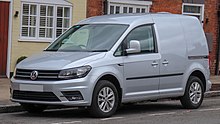


In 2015, it underwent a second facelift consisting of a new front fascia, roof spoiler and a new interior to keep it competitive alongside its more modern rivals. Referred to as Caddy 2K SA (or Mk4/MkIV). It is not based on the new Volkswagen Group MQB platform, but it may be differentiated when compared to the new Touran front end.
Gallery
-

Caddy Panel Van
-

Caddy Maxi Life
-

Caddy Alltrack rugged design details and optional four-wheel -drive
Fourth generation (2020)
| Fourth generation | |
|---|---|
 |
|
| Overview | |
| Production | 2020–present |
| Assembly | Poland: Poznań (Volkswagen Poznan Sp. z o.o.) |
| Body and chassis | |
| Platform | Volkswagen Group MQB platform |
| Powertrain | |
| Engine | 1.5 L EA211-evo series T SI BlueMotion (petrol) 2.0 L EA288-evo series TDI CR (diesel) |

The fourth-generation Caddy was unveiled in February 2020. For the first time, it is based on the Volkswagen MQB platform. The switch to MQB has enabled VW to offer new tech to the Caddy lineup, including Travel Assist, the new oncoming vehicle braking when turning function, connected infotainment systems and digitalized controls. VW is offering the estate and MPV in Kombi, Caddy, Life, Style and Move trim levels, while the delivery van will be offered in Cargo and Cargo Maxi trim levels, with the latter is the designation the long-wheelbase variant. It went on sale in November 2020.
| Type | 1950s | 1960s | 1970s | 1980s | 1990s | 2000s | 2010s | 2020s | |||||||||||||||||||||||||||||||||||||||||||||||||||||||||||||||
| 0 | 1 | 2 | 3 | 4 | 5 | 6 | 7 | 8 | 9 | 0 | 1 | 2 | 3 | 4 | 5 | 6 | 7 | 8 | 9 | 0 | 1 | 2 | 3 | 4 | 5 | 6 | 7 | 8 | 9 | 0 | 1 | 2 | 3 | 4 | 5 | 6 | 7 | 8 | 9 | 0 | 1 | 2 | 3 | 4 | 5 | 6 | 7 | 8 | 9 | 0 | 1 | 2 | 3 | 4 | 5 | 6 | 7 | 8 | 9 | 0 | 1 | 2 | 3 | 4 | 5 | 6 | 7 | 8 | 9 | 0 | |
| Sedan delivery | Caddy I | Caddy II | Caddy III | Caddy IV | |||||||||||||||||||||||||||||||||||||||||||||||||||||||||||||||||||
| Pickup truck | Taro | Amarok | |||||||||||||||||||||||||||||||||||||||||||||||||||||||||||||||||||||
| Campervan | Westfalia California | California (T5) | California (T6) | ||||||||||||||||||||||||||||||||||||||||||||||||||||||||||||||||||||
| Panel van derivatives | Type 2 (T1) | Type 2 (T2) | Transporter (T3) | Transporter (T4) | Transporter (T5) | Transporter (T6) | |||||||||||||||||||||||||||||||||||||||||||||||||||||||||||||||||
| LT I | LT II | Crafter | |||||||||||||||||||||||||||||||||||||||||||||||||||||||||||||||||||||
|
Concepts and future models: Microbus Concept |
|||||||||||||||||||||||||||||||||||||||||||||||||||||||||||||||||||||||
|
|||||||||||||||||||||||||||||||||||||||||||||||||||||||||||||||||||||||
| Type | 1980s | 1990s | 2000s | 2010s | 2020s | |||||||||||||||||||||||||||||||||||||
| 0 | 1 | 2 | 3 | 4 | 5 | 6 | 7 | 8 | 9 | 0 | 1 | 2 | 3 | 4 | 5 | 6 | 7 | 8 | 9 | 0 | 1 | 2 | 3 | 4 | 5 | 6 | 7 | 8 | 9 | 0 | 1 | 2 | 3 | 4 | 5 | 6 | 7 | 8 | 9 | 0 | 1 | |
| City car | up! | |||||||||||||||||||||||||||||||||||||||||
| Subcompact car | Gol I | Gol II | ||||||||||||||||||||||||||||||||||||||||
| Gol III | ||||||||||||||||||||||||||||||||||||||||||
| Fox | ||||||||||||||||||||||||||||||||||||||||||
| Polo IV | Polo VI | |||||||||||||||||||||||||||||||||||||||||
| Voyage / Gol Sedan I | Voyage / Gol Sedan II | |||||||||||||||||||||||||||||||||||||||||
| Polo Classic | ||||||||||||||||||||||||||||||||||||||||||
| Polo Sedan | Virtus | |||||||||||||||||||||||||||||||||||||||||
| Parati / Gol Country I | Parati / Gol Country II | |||||||||||||||||||||||||||||||||||||||||
| SpaceFox / Suran | ||||||||||||||||||||||||||||||||||||||||||
| Compact car | Fusca | Fusca | New Beetle | Beetle / Fusca | ||||||||||||||||||||||||||||||||||||||
| Brasilia | Pointer | Golf III | Golf IV | Golf VII | ||||||||||||||||||||||||||||||||||||||
| Apollo | Logus | Bora | Bora | Jetta / Vento | Jetta / Vento | |||||||||||||||||||||||||||||||||||||
| Large family car | Passat I | Passat IV | Passat V | Passat VI | Passat VII | Passat VIII | ||||||||||||||||||||||||||||||||||||
| Santana I / Passat II | Santana IF | Santana II | ||||||||||||||||||||||||||||||||||||||||
| Subcompact Crossover SUV | Nivus | |||||||||||||||||||||||||||||||||||||||||
| T-Cross | ||||||||||||||||||||||||||||||||||||||||||
| Compact Crossover SUV | Taos | |||||||||||||||||||||||||||||||||||||||||
| Tiguan I | Tiguan II | |||||||||||||||||||||||||||||||||||||||||
| Mid-size SUV | Touareg I | Touareg II | Touareg III | |||||||||||||||||||||||||||||||||||||||
| Van | Caddy / Van | |||||||||||||||||||||||||||||||||||||||||
| Pickup truck | Saveiro I | Saveiro II | Saveiro III | |||||||||||||||||||||||||||||||||||||||
| Amarok | ||||||||||||||||||||||||||||||||||||||||||
| Panel van | Kombi | |||||||||||||||||||||||||||||||||||||||||
|
||||||||||||||||||||||||||||||||||||||||||
| Type | 1980s | 1990s | 2000s | 2010s | 2020s | ||||||||||||||||||||||||||||||||||
| 4 | 5 | 6 | 7 | 8 | 9 | 0 | 1 | 2 | 3 | 4 | 5 | 6 | 7 | 8 | 9 | 0 | 1 | 2 | 3 | 4 | 5 | 6 | 7 | 8 | 9 | 0 | 1 | 2 | 3 | 4 | 5 | 6 | 7 | 8 | 9 | 0 | 1 | ||
| Subcompact/ supermini (B) |
hatchback | Gol II | |||||||||||||||||||||||||||||||||||||
| Polo → Polo Jinqing IV | |||||||||||||||||||||||||||||||||||||||
| Polo V | Polo Plus VI | ||||||||||||||||||||||||||||||||||||||
| sedan | Polo → Polo Jingqu IV | ||||||||||||||||||||||||||||||||||||||
| Compact (C) | hatchback/ station wagon |
Santana Variant I | Gran/Cross Santana II | ||||||||||||||||||||||||||||||||||||
| Gran/Cross Lavida II | Gran Lavida III | ||||||||||||||||||||||||||||||||||||||
| C-Trek | |||||||||||||||||||||||||||||||||||||||
| Golf IV → Bora HS | Golf VI | Golf VII | |||||||||||||||||||||||||||||||||||||
| Golf Sportsvan | |||||||||||||||||||||||||||||||||||||||
| sedan | Santana I | Santana II | |||||||||||||||||||||||||||||||||||||
| Jetta I | Jetta II | ||||||||||||||||||||||||||||||||||||||
| Lavida → Lavida Classic I | |||||||||||||||||||||||||||||||||||||||
| Lavida → Lavida Qihang II | |||||||||||||||||||||||||||||||||||||||
| Lavida Plus III | |||||||||||||||||||||||||||||||||||||||
| Citi Golf | Bora → Bora Classic I | ||||||||||||||||||||||||||||||||||||||
| Bora II | Bora → Bora Classic III | ||||||||||||||||||||||||||||||||||||||
| Bora IV | |||||||||||||||||||||||||||||||||||||||
| Lamando | |||||||||||||||||||||||||||||||||||||||
| Sagitar I | Sagitar II | Sagitar III | |||||||||||||||||||||||||||||||||||||
| Mid-size sedan (D) | Passat → Passat Classic V | ||||||||||||||||||||||||||||||||||||||
| Passat Lingyu | Passat NMS I | Passat VIII | |||||||||||||||||||||||||||||||||||||
| Magotan I | Magotan II | Magotan III | |||||||||||||||||||||||||||||||||||||
| CC I | CC II | ||||||||||||||||||||||||||||||||||||||
| Executive sedan (E) | Phideon | ||||||||||||||||||||||||||||||||||||||
| Subcompact SUV (B) | T-Cross | ||||||||||||||||||||||||||||||||||||||
| Tacqua | |||||||||||||||||||||||||||||||||||||||
| T-Roc | |||||||||||||||||||||||||||||||||||||||
| Compact SUV (C) | Tharu | ||||||||||||||||||||||||||||||||||||||
| ID.4 X | |||||||||||||||||||||||||||||||||||||||
| ID.4 Crozz | |||||||||||||||||||||||||||||||||||||||
| Tiguan → Tiguan Silk Road I | |||||||||||||||||||||||||||||||||||||||
| Tiguan L II | |||||||||||||||||||||||||||||||||||||||
| Tayron | |||||||||||||||||||||||||||||||||||||||
| Mid-size SUV (D) | ID.6 X | ||||||||||||||||||||||||||||||||||||||
| ID.6 Crozz | |||||||||||||||||||||||||||||||||||||||
| Teramont | |||||||||||||||||||||||||||||||||||||||
| Talagon | |||||||||||||||||||||||||||||||||||||||
| Compact MPV | Touran I | Touran L II | |||||||||||||||||||||||||||||||||||||
| Caddy III | |||||||||||||||||||||||||||||||||||||||
| Full-size minivan | Viloran | ||||||||||||||||||||||||||||||||||||||
| Manufactured by SAIC-Volkswagen Manufactured by FAW-Volkswagen Excluding imported models |
|||||||||||||||||||||||||||||||||||||||
|
|||||||||||||||||||||||||||||||||||||||





